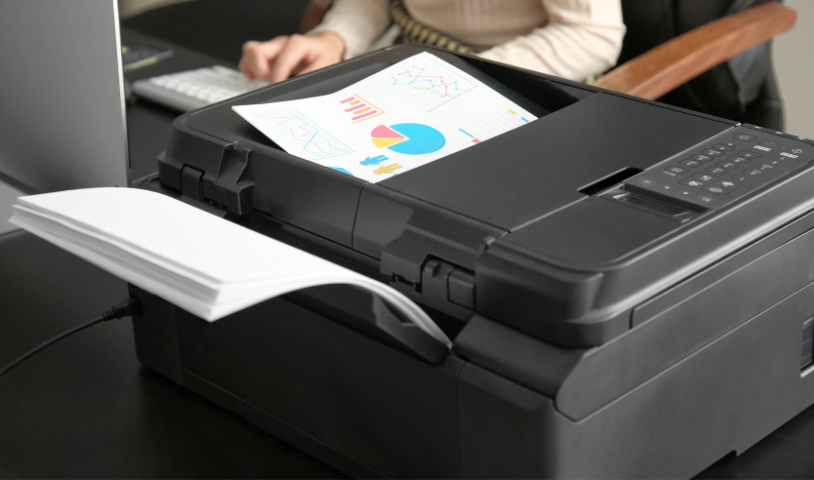Print Management is the ability to control printers and printing across your organization.
In this guide we explore the different types of print management systems, covering deployment management, configuration control, print monitoring and security considerations. Plus a touch of print history for context.
To begin at the beginning [of print]*…
Printing – the act of transferring digital text and images to paper, was one of the first key uses of computers. Some of the technology developed back in the 1970’s and 80’s to enable printing still lingers-on in printer hardware and printer software today.
The fact that 70’s & 80’s technology is still in use today is a testament to the design skills and foresight of the inventors. Don’t take my word for it: check out the history of the LPD protocol (dating back to ’83) which you’ll still find in new printers today, amazing (and scary maybe?).
There are a host of other print technologies that have their roots near the beginning of computing such as PostScript, PCL and SNMP which have lasted the test of time, even flourished since, to become integral parts of many print management solutions today.
Print management software has evolved significantly over the years. Starting with ‘mainframe‘ printer interfacing, progressing through the Windows Desktop (Centronics 36-PIN adaptors anyone?) and Windows Server (GPO, branch-office and PrintNightmare) era and now firmly embracing Cloud and all the advantages that Software As A Service has to offer.
It’s an exciting time in print hardware and software, producing a huge industry shifts, which will ultimately benefit the end-user. Will the print technology innovations of 2022 still be going strong 40-something years later?
Key types of Print Management (definitions)
There are a few Industry interpretations of ‘Print Management’ which are often confused or conflated.
We attempt to list and explain the different terminology that you will find when exploring print management solutions out there on the web.
The diagram shows the different areas within the definition of ‘print management’. Excluding commercial print technology for clarity.
While not definitive, this venn diagram gives a useful overview of the general areas considered to be within the domain of print management as understood in 2022.
- Queue management: Controlling which print queues a user can see including management of ‘branch-offices’ etc.
- Driver management: Ensuring that the correct Xerox, Canon, Sharp, HP, Konica Minolta drivers are correctly in installed on the endpoint, such as a Windows, Mac or Chromebook device
- Cloud print and follow-me (pull) printing solutions that allow users to print from anywhere to any printer.
- Printer monitoring: Getting visibility of toner supplies, errors, paper jams etc.
- Output monitoring: Getting visibility of print volumes by users, departments or organizations.
- Output control: Controlling print quotas for individuals or departments.
- Output security: Ensuring that documents only end up in the hands of authorised personnel, normally the person who prints it.
- Fleet management: Deploying configuration changes to multiple printers – an IT admins ‘most tedious task’, if not automated.
- Commercial print management: Used by print-shops to produce banners, magazines, specialist and large-format prints.
Of course, information/cyber security underpins all of the above and should be integral to any requirement analysis, especially for enterprise and education customers who are examining their future print management options.
The advantages of print management
Of course it’s possible to locally install printer drivers on a workstation or laptop, without the need for a print management system.
Without print management end-users or administrators would be responsible for local printer configuration management and driver updates. This can be a time-consuming and frustrating process.
With no print management in place, administrators and budget holders would have little or no visibility of print activity and volumes. For most large organizations this would represent a cost and security risk.
Who’s using print management?
Organizations requiring print management solutions generally fall into two categories: Direct and indirect print management users.
- Any organization with employees / students / volunteers / visitors that wants to control and track printing to their owned or leased printers, they will typically (see exception below) manage their own toner supplies and printer servicing. These organizations usually want to streamline deployment or limit access to printers across a large user base. Enterprises, schools, districts and higher education establishments, medical settings and public spaces such as libraries are typical of this class of organization requiring print management.
- Managed print services (MPS) providers that offer pay-per-print services or lease printers to an organization. The MPS provider will need to know the volume of color and black & white (mono) printing that an organisation does, so that they can correctly bill for ‘metered’ usage. This will typically involve the deployment of an MPS monitoring solution (e.g. MPS Monitor) to allow the MPS provider to track this data.
Given the breadth of the term ‘Print management’ it is common to find organizations who will take a Managed Print Service from an MPS provider [who will have their own print monitoring], but will still require an in-house print management solution for queue management, driver management, output control and output security, see the definitions above. NB ‘in-house’ does not mean on-premise, they could (should?) use a Cloud based service (SaaS) to control, manage and track printing.
The use of ‘print management’ and ‘managed print’ in this context can be confusing and should be disambiguated whenever possible.
The Evolution of Print Management: From servers to the Cloud
Like most other IT functions, print management can now be deployed in a number of ways.
Historically print management has been an ‘on-prem’ server-hosted solution such as Windows Print Services (integrated into Windows server), Papercut MF and Canon Uniflow to name a few.
Each of these solutions solves different aspects of the broader print management challenge, but will require one or multiple servers, virtual-servers and licenses to be deployed within and organization.
Gartner estimates that the all-in cost of running a print-server on an annual basis is around $5000, leading many to conclude it’s time to ditch the print server.
With ever-tightening IT budgets, a focus on efficiency, print management is not immune from the shift towards the Cloud. Spending less time on server hardware and more time on strategic growth and operational efficiency initiatives is the mission of many COOs.
Google tried to bring print management into the 21st century with its innovative ‘Google Cloud Print‘ solution. For a variety of reasons it did not succeed and has since been retired, but it did herald a new era of Cloud-first print management solutions. The key selling point of these solutions is that they allow printing from any device connected to the Internet to any printer inside an organization – very convenient, especially in our post-pandemic, remote-worker enabled world.
In 2022, the print hardware and software industry is in a state of flux. Cloud technology is a major disruptor to this long-established industry. ‘Cloudifying print’ offers huge operational efficiency advantages for consumers, while simultaneously hardware commoditization and supply pressure is squeezing OEMs (see definition below).
Breakthrough companies such as directprint.io and Tricerat offer distinct SaaS-centric solutions to the market, causing innovation & price pressure on established / incumbent / legacy print print management providers.
These new Cloud-first solutions are often referred to as ‘serverless’ solutions because they don’t require deployment of server hardware or VMs within an organization.
In taking a pure-Cloud approach to this traditional (30 year old) market, some of these companies are benefiting from the broader industry trend of Cloud adoption and offering new solutions at aggressive price points.
Print management Summary
Although the definition of print management is wide, the general industry interpretation is:
“A system provide control over printers and printing within an organization”
When it comes to choosing a print management solution, examine your requirement set:
- Do you need to control over your users’ print volumes?
- Do you need queue management (see above)?
- Is cloud printing or pull printing a use-case for your organization?
- Is tracking print volume and cost control a requirement?
- Do you need realtime notifications of out of paper and toner runout situations?
- Do you just need configuration control over the printers in your network?
- Print & document security – this is a very large topic and will be covered in a forthcoming blog piece.
You’ll find products tend to fit into these broad areas:
- Queue and endpoint management
- Print activity control and reporting
- Remote printing enablement (cloud printing)
- Fleet management
- Printer monitoring
Some companies offer multiple products covering these different functional areas.
We hope this whirlwind tour of Print Management has been informative, please email any corrections or comments to us.
Read more like this
To get more information on some of the challenges in print management in Education check out some of our blog posts here and here.
This guide hasn’t covered some of the more esoteric challenges of receipt and label printing – huge issues for retail, warehousing and logistics companies. Read more on that challenge here.
All trademarks are the the property of their respective owners.
Glossary of terms
- Endpoint: A computer, typically a Windows, Mac or Chromebook
- OEM: Original Equipment Manufacturer, in the printer world that’s Xerox, HP, Sharp, Canon, Konica Minolta, Kyocera, Brother etc. These are the guys who make the printer hardware and supply drivers.
- Print queue: A place to send print jobs – normally associated with a printer to produce output.
- Public cloud: A service hosted on AWS, Azure Google Cloud or similar
- Private cloud: A Platform as a service, hosted by an Organization (typically in a data center)
- Hybrid cloud: A mix of on-prem, private and public cloud hosting options and the ability to switch between them depending on scalability and security requirements.
- COO: Chief Operating Officer – responsible for the day-to-day and strategic operations of a company – efficiency is often a focus
- VM: Virtual machine. A machine within a machine, e.g. VMWare running multiple Windows operating systems on a single piece of hardware, synonymous with virtualization. Not to be confused with Virtual Desktops (VDI), which is about emulating a full desktop environment for end-users.
* directprint.io is a Welsh company: Under Milk Wood by Dylan Thomas is one of the best plays ever written, but we’re biased…


